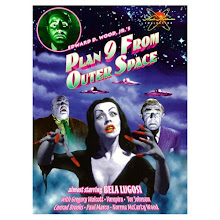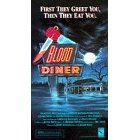by Jason Pyles / January 25, 2009
“Dogville” cannot be accurately conveyed through mere description. The only way to know “Dogville” is to endure it.
I say endure not because the film is three hours long and set like a sparse stage play, rather, I say endure because of the way it drags us through twisted bouts with morality. Somehow, amid its minimalistic design, “Dogville” manages to expose the heinous depths to which human nature is capable of plummeting.
And what’s more, the film’s concluding scenes make us root for deplorable (albeit retributive) behavior. The former victim makes victims of her abusers, sinking to their inhumanity, and our spectator’s gladness thereby incriminates us vicariously. Thus we realize that writer and director, Lars von Tier, has lured us into validating his film’s apparent assertion that bubbling beneath the exterior of us all are evil acts waiting to spring forth. After all, Grace hoped for a different lifestyle, but small-town Dogville squelches her hope; goodness is mythical, she seems to decide.
Though “Dogville” is a magnificent film, it’s not profound. Many other films have reached similarly sad conclusions. Aside from the emotional responses it provokes, “Dogville’s” meanness is only matched by its unusualness. I cannot think of another motion picture quite like this one.
Though the film is set in the late 1930s, early ’40s, “Dogville” reminds me of something Nathaniel Hawthorne might have written to comment on the sociology of Puritanism, particularly with regard to issues of morality.
The film’s shabby stage is adorned, here and there, with occasional physical objects of set design, but the bleak stage is nonetheless prominent. Similarly, the residents of the township of Dogville dress up their viciousness with the illusion of simple values and piety, but their monstrous natures are ever visible through their invisible homes. We witness the first rape in a long shot from across the town. One can’t help but wonder, through the film’s “illustrations,” how differently we might behave if our walls were also transparent.
Setting aside the multiple rapes, the human dog chain (a masterstroke), the heartless breaking of figurines and parallel ruthless execution of children, “Dogville” offers other stimulating considerations for lovers of the filmic medium: We’ve seen plays and we’ve seen films; we’ve also seen filmed plays. But to me “Dogville” is something more, because it overlaps the two and reveals the fine line between them.
I suppose nearly all actors in films and plays emit the illusion of total acceptance of their surroundings; seemingly convinced themselves that their props are real, we also agree to believe. But in “Dogville” the vehicles that drive in and out of “the town” are just as tangible to the cast as the doors that we cannot perceive, yet the actors still knock, open and close those doors and we still hear each action.
We also hear other things that we know aren’t there: crickets, rain, thunder. And the set is given visual additions, such as the fog and snow. All of these could also be presented in a play. Even the condensing of time is characteristic of both plays and movies.
Yet “Dogville” strikes me as more than just a filmed play: I was astounded at my willingness to be deluded into overlooking blatant artificiality and perceiving this odd town and its appalling goings-on as reality.
The very last shot shows us “Moses,” the dog, in actuality — the same dog that before we could only hear or see a chalk drawing of. This final moment reinforced my illusion, and for an instant, made me think to myself, ‘See? This is really happening! Even the invisible objects were truly there all along.’
Sunday, January 25, 2009
Thursday, January 22, 2009
81st Academy Awards Nominees
To see a list of the nominees announced earlier today, visit my movie review site:
www.rhapsidiommoviereviewer.blogspot.com
Jason
www.rhapsidiommoviereviewer.blogspot.com
Jason
Wednesday, January 14, 2009
Caught in "Traffic"
by Jason Pyles / January 14, 2009
This week’s film is “Traffic,” which was selected by Andrew James. I’m interested to know why he chose this as an example of an unusual film.
After some thought, I concluded that the most unusual aspect about “Traffic” is that it’s actually a drama about the illegal drug industry — and not a shoot-‘em-up action flick. Most movies with a backdrop of drug wars have gun battle after gun battle, but “Traffic” sticks to its agenda as a message film.
At the 73rd Academy Awards, which recognized the films of 2000, “Traffic” was nominated for Best Picture, contending with “Chocolat,” “Crouching Tiger, Hidden Dragon,” “Erin Brockovich” and that year’s winner, “Gladiator.” The director of “Traffic,” Steven Soderbergh, won Best Directing for this film, but he was also nominated again that same year for “Erin Brockovich,” which he also directed. Robert Osborne, who writes the “Official History of the Academy Awards” notes that a director hasn’t had dual contenders for Best Picture since the 1948 Oscars; nor has a director competed with himself with two films in Best Directing since 1938.
“Traffic” also afforded Benicio Del Toro an Oscar for Supporting Actor, Stephen Gaghan for its Writing, and Stephen Mirrione for its Film Editing.
Some aspects of the film-style are blatant: Notice that the scenes that take place in Mexico are typically a little overexposed and have an overall yellow, sun-bleached tint, as if looking through those cheap, yellow-lens sunglasses. And the scenes set in D.C. and Ohio have a bluish tone. Other than differentiating the story lines, I’m not sure what purpose these colors served, unless they were simply artistic whimsy.
I enjoyed how the stories would barely graze one another, overlapping from time to time — typically with a passing vehicle or a pedestrian. The film’s other prevalent stylistic decision is an unusual but wonderful shot that appears to be upside down as the camera (aka “we”) watch a helicopter land on top of it.
I’ve loved Benicio Del Toro in everything I’ve ever seen him in, but I’m still not sure why he got an Oscar for this role; though I’m not particularly fond of the actress, Erika Christensen’s drug addict “Caroline” is notably persuasive during her trips, and perhaps more deserving of recognition.
So what is the message? The tagline is “No One Gets Away Clean,” which is convincingly depicted in “Traffic.” In summary I think the film is trying to tell us the War on Drugs is ultimately futile, but the dangerous and costly efforts matter to those individuals who receive assistance. But still, no one gets away clean.
This week’s film is “Traffic,” which was selected by Andrew James. I’m interested to know why he chose this as an example of an unusual film.
After some thought, I concluded that the most unusual aspect about “Traffic” is that it’s actually a drama about the illegal drug industry — and not a shoot-‘em-up action flick. Most movies with a backdrop of drug wars have gun battle after gun battle, but “Traffic” sticks to its agenda as a message film.
At the 73rd Academy Awards, which recognized the films of 2000, “Traffic” was nominated for Best Picture, contending with “Chocolat,” “Crouching Tiger, Hidden Dragon,” “Erin Brockovich” and that year’s winner, “Gladiator.” The director of “Traffic,” Steven Soderbergh, won Best Directing for this film, but he was also nominated again that same year for “Erin Brockovich,” which he also directed. Robert Osborne, who writes the “Official History of the Academy Awards” notes that a director hasn’t had dual contenders for Best Picture since the 1948 Oscars; nor has a director competed with himself with two films in Best Directing since 1938.
“Traffic” also afforded Benicio Del Toro an Oscar for Supporting Actor, Stephen Gaghan for its Writing, and Stephen Mirrione for its Film Editing.
Some aspects of the film-style are blatant: Notice that the scenes that take place in Mexico are typically a little overexposed and have an overall yellow, sun-bleached tint, as if looking through those cheap, yellow-lens sunglasses. And the scenes set in D.C. and Ohio have a bluish tone. Other than differentiating the story lines, I’m not sure what purpose these colors served, unless they were simply artistic whimsy.
I enjoyed how the stories would barely graze one another, overlapping from time to time — typically with a passing vehicle or a pedestrian. The film’s other prevalent stylistic decision is an unusual but wonderful shot that appears to be upside down as the camera (aka “we”) watch a helicopter land on top of it.
I’ve loved Benicio Del Toro in everything I’ve ever seen him in, but I’m still not sure why he got an Oscar for this role; though I’m not particularly fond of the actress, Erika Christensen’s drug addict “Caroline” is notably persuasive during her trips, and perhaps more deserving of recognition.
So what is the message? The tagline is “No One Gets Away Clean,” which is convincingly depicted in “Traffic.” In summary I think the film is trying to tell us the War on Drugs is ultimately futile, but the dangerous and costly efforts matter to those individuals who receive assistance. But still, no one gets away clean.
Wednesday, January 7, 2009
Water - comments by Andy
Wow Barrett. What a fantastically depressing movie. Thanks for totally killing my buzz. What a stark difference between the young kids in "Water" and "Billy Elliot." I watched this with my wife, and, as usual, I fell asleep in the middle. I dozed off with the certainty that everything was going to be just fine; that Chuyia would break the mold that was the vicious cycle of making widows third-class citizens. Not so much.
I too thought this movie was the most brilliant, beautiful, well-acted, totally depressing movie I've ever seen. And now I'll try to forget it.
by Andy
I too thought this movie was the most brilliant, beautiful, well-acted, totally depressing movie I've ever seen. And now I'll try to forget it.
by Andy
Thursday, January 1, 2009
Poring Over "Water"
by Jason Pyles
Though it looks like a film from India, “Water” is technically a Canadian film that was set in India, filmed in Sri Lanka, and written and directed by the Indian-born Deepa Mehta. (And today — January 1 — I noticed, happens to be Mehta’s birthday.)
“Water” was nominated for an Academy Award in 2006 for best foreign language film but was beat out by Germany’s “The Lives of Others.” Also, “Water” is part of a trilogy and is preceded by Mehta’s films “Fire” (1996) and “Earth” (1998), which I haven’t seen.
When movies begin with some kind of ominous prologue, my interest is immediately piqued:
A widow should be long-suffering until death, self-restrained and chaste. A virtuous wife who remains chaste when her husband has died goes to heaven. A woman who is unfaithful to her husband is reborn in the womb of a jackal.
We’re told this comes from “Sacred Hindu texts.” And we know that what follows will be a widow who disobeys the edict. But what we don’t know is that the widow who introduces us to the aforementioned disobedient widow will be about 7 years old.
It is immediately difficult not to be judgmental of this belief system. And for those of us who attempt to approach “Water” with an open mind, Mehta antagonizes further because she has an agenda: We are shown vividly how some widows in India around 1938 (and still today) are neglected and mistreated. As I watched, I couldn’t stop thinking of how lepers were similarly detested in the Bible. Naturally, the grotesque irony in “Water” is how Kalyani (Lisa Ray) was no longer good enough to speak to men, but she could be prostituted for income and treats.
These surface observations have deeper implications that tell us this is more than just another sad tale of star-crossed lovers: At first, we may suppose that the vulgar Madhu Didi (aka “Fatty”) and Gulabi (the pimp) were just two bad seeds. But after hearing Narayan’s logistical breakdown about widows being an economic burden on their families, we realize that financing an “ashram” or house of widows may indeed be tricky. So, we are left to wonder if prostitution for survival (because “not even God can question survival”) is not as uncommon as we might suppose.
In an effort not to ramble on, I must finally comment on what a beautiful film “Water” is, particularly its soundtrack. The film’s main lovers’ theme, which may be called “Chanchan,” evokes Rusted Roots’ “Beautiful People,” which I dearly love.
Thanks for choosing this film, Barrett.
Though it looks like a film from India, “Water” is technically a Canadian film that was set in India, filmed in Sri Lanka, and written and directed by the Indian-born Deepa Mehta. (And today — January 1 — I noticed, happens to be Mehta’s birthday.)
“Water” was nominated for an Academy Award in 2006 for best foreign language film but was beat out by Germany’s “The Lives of Others.” Also, “Water” is part of a trilogy and is preceded by Mehta’s films “Fire” (1996) and “Earth” (1998), which I haven’t seen.
When movies begin with some kind of ominous prologue, my interest is immediately piqued:
A widow should be long-suffering until death, self-restrained and chaste. A virtuous wife who remains chaste when her husband has died goes to heaven. A woman who is unfaithful to her husband is reborn in the womb of a jackal.
We’re told this comes from “Sacred Hindu texts.” And we know that what follows will be a widow who disobeys the edict. But what we don’t know is that the widow who introduces us to the aforementioned disobedient widow will be about 7 years old.
It is immediately difficult not to be judgmental of this belief system. And for those of us who attempt to approach “Water” with an open mind, Mehta antagonizes further because she has an agenda: We are shown vividly how some widows in India around 1938 (and still today) are neglected and mistreated. As I watched, I couldn’t stop thinking of how lepers were similarly detested in the Bible. Naturally, the grotesque irony in “Water” is how Kalyani (Lisa Ray) was no longer good enough to speak to men, but she could be prostituted for income and treats.
These surface observations have deeper implications that tell us this is more than just another sad tale of star-crossed lovers: At first, we may suppose that the vulgar Madhu Didi (aka “Fatty”) and Gulabi (the pimp) were just two bad seeds. But after hearing Narayan’s logistical breakdown about widows being an economic burden on their families, we realize that financing an “ashram” or house of widows may indeed be tricky. So, we are left to wonder if prostitution for survival (because “not even God can question survival”) is not as uncommon as we might suppose.
In an effort not to ramble on, I must finally comment on what a beautiful film “Water” is, particularly its soundtrack. The film’s main lovers’ theme, which may be called “Chanchan,” evokes Rusted Roots’ “Beautiful People,” which I dearly love.
Thanks for choosing this film, Barrett.
Subscribe to:
Comments (Atom)





























































